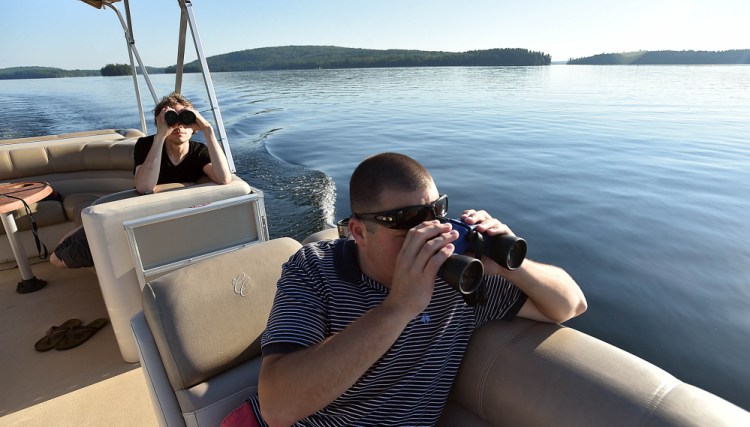ROME — About 20 minutes into a loon-watching excursion Saturday morning on Great Pond, Steven Schoeneck spotted the first black-and-white bird of the day floating on the lake.
“I’ve got one, right off the point, a black dot,” said Schoeneck, 37, gripping his binoculars and pointing across the water.
“Yes sir, that’s a good catch,” said Richard LaBelle, 30, a fellow loon counter out on the water Saturday.
LaBelle, Schoeneck, and Frank Griffin, Schoeneck’s father-in-law, were among more than 900 volunteers in Maine Audubon’s 33rd annual Loon Count on Saturday, a statewide event in which lakes and ponds were surveyed for loons in a scientific and conservation effort.
“The annual count has helped build support for laws that keep our lakes and loons healthy, including regulations around lead-free tackle, shoreline development, and invasive plants,” said Susan Gallo, director of the Maine Loon Project. “It’s also been a great way to get people outside, learning about where loons are, where they nest, and how easy it is to share a lake with a loon family.”
In 2015, 850 volunteers surveyed 290 Maine lakes and ponds, counting a total of 2,818 adult loons and 218 chicks in the southern half of Maine. Although the count takes place statewide, the project has been able to collect reliable data from only the southern half of the state, since there are so few volunteers farther north, Gallo said.
The 2015 number was down about 10 percent from the number counted in 2014, but according to Maine Audubon, the long-term trend for loons remains positive, with last year’s number being about twice the number counted in the first Loon Count, in 1984. Last year’s count was hampered by torrential rain.
The total number of birds cited Saturday was not immediately available, but the small group on Great Pond spotted two – the same number they saw last year.
Griffin, who lives year-round on the pond, said he felt the number was low compared to the number of loons that live around the water and the number he sees regularly.
“Just sitting at the house, you usually see one or two per day,” he said. “It’s when you go out to look for them that you can’t find them.”
The Loon Count takes place on the third Saturday in July, a good time for spotting adults as well as chicks, which hatch between mid-June and mid-July.
Volunteers are assigned to a specific part of a lake or pond so as not to duplicate efforts, and are all asked to conduct their counts from 7 a.m. to 7:30 a.m.
“They sort of systematically search the area and make sure to get all the loons they can find,” Gallo said.
While it would be impossible to count every loon in the state, Gallo said the number calculated during the loon count can be used to extrapolate estimates on lakes and ponds and provide an accurate idea of how many birds there are in the state and how quickly they are reproducing.
Lead fishing tackle is the leading cause of death for adult loons.
Send questions/comments to the editors.




Comments are no longer available on this story